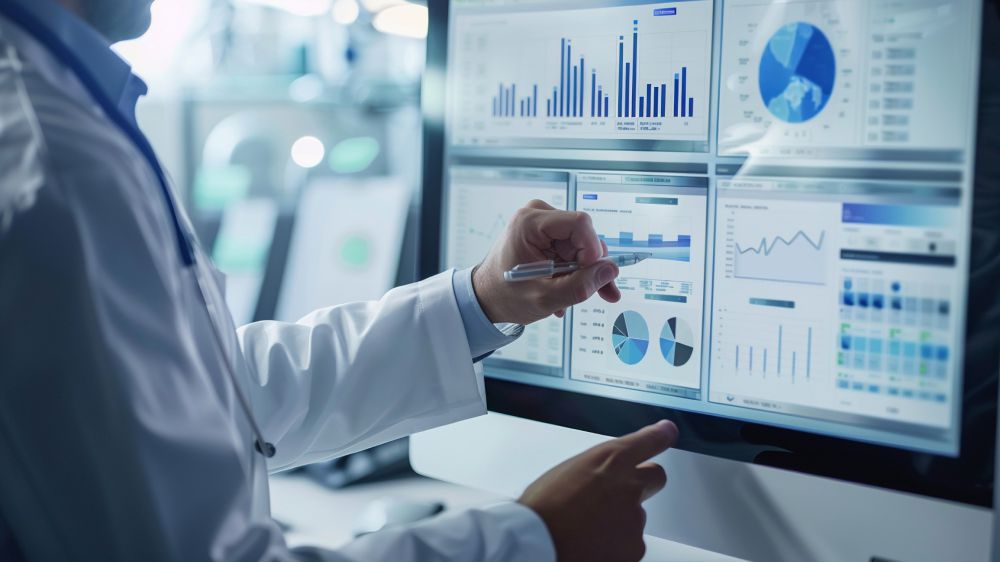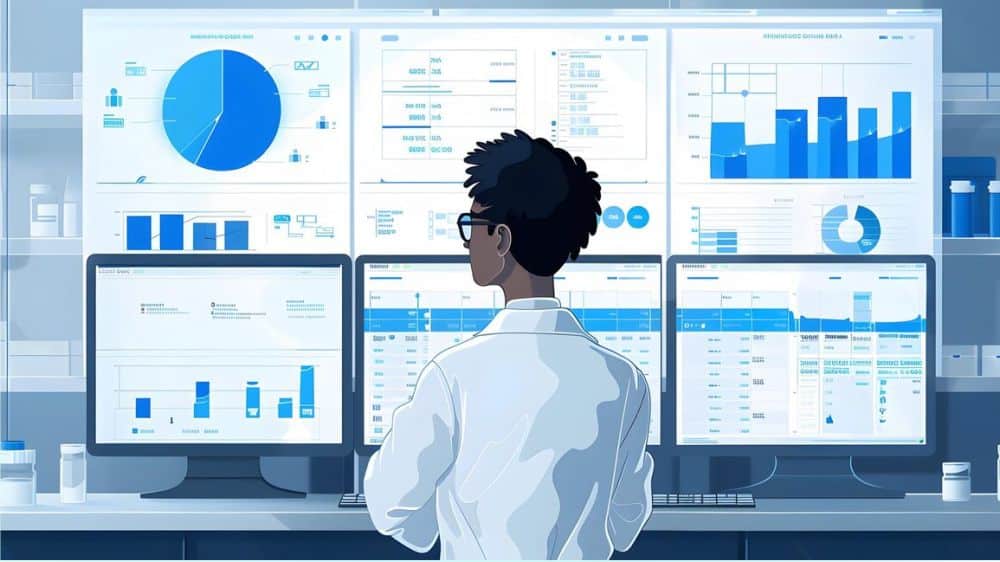AI-driven diagnostic analytics in healthcare is emerging as a linchpin of value-based care, with potential savings of billions of dollars globally. The U.S. healthcare system alone could save an estimated $150 billion annually by 2026.
These stats highlight the role of diagnostic analytics in unlocking the “why” behind crucial data, allowing healthcare providers to understand the root causes of healthcare delivery. With healthcare systems facing mounting pressure to deliver better outcomes while managing costs, diagnostic analytics will open the path to evidence-based practices and operational excellence.
Let’s look at the benefits and limitations of diagnostic analytics in healthcare and how it promises to reshape clinical practices.
What Is Diagnostic Analytics?
Diagnostic analytics is a specialized form of data analysis focusing on uncovering the reasons behind specific outcomes or events. Unlike descriptive analytics, which summarizes what has happened, and predictive analytics, which forecasts what might happen, diagnostic analytics looks at the “why.” Diagnostic analytics analyzes data to identify root causes and explains why an outcome occurred. Then it goes a step further and highlights the key factors and patterns contributing to it.
Diagnostic analytics can answer questions like:
- Why did a specific event or outcome occur?
- What were the main contributing factors or patterns?
- Were there any unusual trends or anomalies, and what caused them?
Diagnostic analytics are a bridge between understanding past results and anticipating future ones. DA provides valuable context that supports more informed and accurate decision-making.
The Role of Diagnostic Analytics in The Medical Field
As healthcare organizations address suboptimal patient outcomes, escalating costs, and retention challenges, diagnostic analytics platforms become increasingly important. By revealing underlying causes, like why a patient required readmission or why a particular treatment failed, diagnostic analytics lets providers identify patterns and tackle any specific obstacles. The insights gained from diagnostic analytics enhance multiple domains in healthcare, including billing accuracy, cost management, surgical efficacy, and reinfection rates, ultimately supporting improvements in patient care and operational efficiency.

Understanding “Why Did This Happen?”
Diagnostic analytics in healthcare gives providers in-depth insights into the causes behind specific events, outcomes, or behaviors. It examines the root causes and underlying patterns contributing to clinical or operational outcomes. For instance, if a hospital experiences an increase in patient readmissions, diagnostic analytics can identify the contributing factors, such as gaps in post-discharge follow-up, misdiagnosis, or ineffective treatment plans.
With a clearer understanding of why specific outcomes occur, healthcare providers can refine treatment plans, target interventions more effectively, and make informed decisions based on actionable insights.
Training AI-Based Healthcare Analytics Models and Chatbots
AI-powered diagnostic tools, such as chatbots, are trained on healthcare data to detect signs of disease, symptoms, and possible treatments. Modern AI-driven systems will act as patients’ first point of contact, guiding them toward the appropriate medical services.
Chatbots give timely recommendations to ensure patients receive the proper care at the right time, reducing the burden on healthcare facilities, and improving patient satisfaction.
Helping Physicians Stay Updated with Medical Knowledge
AI platforms in healthcare provide physicians with easy access to the latest research, treatment techniques, and medical innovations. These platforms help improve diagnostic accuracy by ensuring that healthcare professionals are always informed of the most up-to-date medical practices and findings.
By enhancing the knowledge base of physicians, AI-driven tools contribute to better patient care, more accurate diagnoses, and overall improvements in the healthcare experience.
Understanding How Diagnostic Analytics in Healthcare Works
Diagnostic analytics in healthcare is systematic process of examining historical data to identify the root causes of specific issues, uncover patterns, and improve decision-making.

To ensure that data provides valuable insights aligned with business goals, diagnostic analytics typically follow these seven essential steps:
1. Define the Problem
Begin by clearly defining the event, outcome, or business issue you aim to investigate. Crafting a precise problem statement shows you the scope of analysis so you can focus efforts where they matter.
2. Gather Necessary Data
Identify and gather relevant data from all necessary sources, such as customer transactions, marketing activities, or operational metrics. Comprehensive data collection ensures all relevant factors are considered, leading to a more accurate analysis.
3. Process the Data
Preprocess the data for accuracy by handling missing values, removing redundancies, and checking for duplicates. This cleaning step ensures the data is reliable and ready for meaningful analysis.
4. Utilize Statistical Techniques
Select appropriate statistical methods, including hypothesis testing or regression analysis, that identify factors influencing the event or outcome. Choosing the proper techniques sharpens the precision of findings and helps uncover significant contributing factors.
5. Select the Appropriate Analytics Method
Apply suitable analytical methods to explore patterns and establish relationships between variables. Statistical analysis enables deeper insights, revealing connections that may otherwise go unnoticed and supporting robust conclusions.
6. Visualize the Data
Use data visualization tools to highlight patterns, anomalies, or outliers. Visual representations make identifying trends and unusual behaviors easier, aiding in a more precise interpretation of the data.
7. Analyze the Findings
Assess the insights gained to develop actionable strategies for problem-solving, optimizing processes, or seizing new opportunities. Converting insights into strategies ensures that analysis drives practical improvements in decision-making and business outcomes.
Key Benefits of Diagnostic Analytics in Healthcare
In the past decade, businesses have become more dependent than ever on data. Diagnostic Analytics tools and techniques allow companies to understand their datasets and the insights they generate.
Here are the top benefits of using diagnostic analytics:
1. Enhanced Clarity
Diagnostic analytics in healthcare can uncover operational bottlenecks and inefficiencies by thoroughly examining historical data. Identifying areas where workflows slow down or resources are misallocated lets healthcare providers gain valuable clarity into their processes.
Insights from this analysis enable targeted workflow optimization, more effective resource allocation, and reduced delays, ultimately enhancing the efficiency and quality of care.
2. Informed Decision-Making
Healthcare leaders benefit from diagnostic analytics by uncovering trends, anomalies, and patterns that often go unnoticed, providing an evidence-based foundation for strategic decision-making. These concrete insights guide planning and execution, enabling leaders to make informed, data-driven decisions.
By focusing on evidence rather than assumptions, healthcare organizations can allocate resources more effectively, reduce unnecessary procedures, and improve staff utilization, ultimately enhancing both the quality and sustainability of healthcare services.
3. Increased Patient Satisfaction
Diagnostic analytics allows healthcare providers to analyze patient behavior and satisfaction data to uncover factors driving patient dissatisfaction or decisions to leave. Healthcare organizations can make targeted improvements that address specific patient expectations by pinpointing unmet needs and service gaps.
4. Reduced Risk Exposure
Diagnostic analytics enhances risk management by using historical data and trend analysis to identify potential threats before they escalate. By examining past events and outcomes, healthcare organizations can uncover specific areas of vulnerability, allowing them to implement targeted preventive measures.

Real-life Use Cases of Diagnostic Analytics in Healthcare
Diagnostic analytics transforms healthcare by providing actionable insights that streamline workflows, optimize resource allocation, and reduce delays. Here are some key examples of how this approach is being utilized to enhance healthcare outcomes:

1. Reducing Hospital Readmission Rates
One of the most pressing issues for hospitals is high patient readmission rates, which affect patient outcomes and result in financial penalties under value-based care models. Diagnostic analytics helps hospitals identify the root causes of readmissions by analyzing data such as discharge procedures, follow-up care adherence, and patient demographics.
For instance, a hospital might discover that patients with chronic conditions like heart failure are frequently readmitted due to inadequate post-discharge monitoring. Providers can then implement targeted interventions such as remote patient monitoring or enhanced patient education programs to reduce readmissions and improve long-term outcomes.
2. Preventing Medication Errors
Medication errors pose significant risks to patient safety and can lead to severe health complications. Diagnostic analytics aids in identifying patterns that contribute to these errors by analyzing prescribing habits, patient medical histories, and pharmacy operations.
Healthcare organizations can use this insight to develop safety measures such as electronic prescribing systems with built-in alerts or additional staff training.
3. Improving Resource Utilization in Operating Rooms
Operating rooms are among the most resource-intensive areas in any healthcare facility, and inefficiencies can lead to significant cost overruns. Diagnostic analytics helps surgical teams optimize resource use by examining data related to surgery durations, equipment usage, and staff schedules.
Healthcare providers can adjust scheduling practices, improve pre-operative workflows, and ensure that critical resources are available when needed.
4. Personalizing Chronic Disease Management
Managing chronic conditions requires a tailored approach that addresses individual patient needs. Diagnostic analytics allows you to analyze patient data, including health records and lifestyle factors, to develop personalized care plans for each patient.
Consider a case where the data showed a subset of patients experience frequent blood sugar spikes after meals despite following a prescribed diet. With the help of AI-powered diagnostic analytics, providers can personalize care by recommending alternative dietary plans or adjusting insulin dosages.
Read more: Top 8 Applications of Data Analytics in Healthcare
Potential Drawbacks of Diagnostic Analytics in Healthcare
While diagnostic analytics innovates approaches, it also comes with certain limitations. Here are some potential drawbacks to be aware of:

1. Limited Predictive Capability
Diagnostic analytics in healthcare focuses on understanding past data and identifying the causes behind past events. It can’t predict future outcomes with certainty. While it offers valuable insights into what happened, it cannot forecast future events, making it less helpful in anticipating new trends or scenarios.
Healthcare organizations can combine diagnostic analytics with predictive models to address this limitation. Integrating predictive analytics allows for more accurate forecasting and proactive decision-making based on past and future insights.
2. Requirement for Complementary Data Sources
Diagnostic analytics in healthcare relies on historical data but often requires supplementary data from real-time monitoring systems or third-party sources to provide a fuller context. Without real-time data, the analysis may fail to reflect the current situation or changing circumstances.
Integrating real-time data from systems like EHRs and patient monitoring tools ensures a more dynamic and accurate analysis. Combining historical and current data offers a more comprehensive understanding and supports better decision-making.
3. Risk of Misinterpreting Data Relationships
Misinterpreting data relationships poses a risk of faulty conclusions and poor decision-making. Also, misunderstanding the connections between variables can result in incorrect assumptions and costly strategic errors in healthcare settings.
Organizations should use expert analytical methods and validation processes to mitigate this risk. Ensuring analysts are trained to distinguish between correlation and causation can help prevent misunderstandings and save money.
4. Higher Complexity and Skill Demand
Diagnostic analytics in healthcare requires more time and specialized skills than straightforward methods like descriptive analytics. Healthcare organizations may face challenges finding the necessary talent or resources to perform in-depth analyses effectively.
Given the complexity, there is a clear need for skilled professionals in data analytics. To overcome this challenge, healthcare organizations can partner with reliable technology vendors, such as KMS Healthcare, to access expert guidance and advanced tools.
Unlock the Potential of Diagnostic Analytics with KMS Healthcare
Diagnostic analytics uncovers the root causes behind healthcare outcomes, enabling organizations to transform both operational workflows and patient engagement strategies. By analyzing historical data, healthcare providers can identify patterns that predict patient readmissions, optimize staffing schedules based on real-time demand, and improve diagnostic accuracy by spotting trends that might otherwise be overlooked.
At KMS Healthcare, we help healthcare organizations implement tailored diagnostic analytics solutions that drive fundamental improvements:
- Healthcare Expertise: Our platform-certified experts understand healthcare data. We design solutions that align with your clinical needs and regulations.
- Advanced Analytical Tools: Our AI-powered models provide insights to enhance operational efficiency and patient outcomes.
- Data Management: Scalable healthcare data management solutions make business functions agile, especially during AI and automation transformations.
→ Contact us to explore how KMS Healthcare can help you harness diagnostic analytics to reduce unnecessary treatments and enhance resource efficiency across your organization.